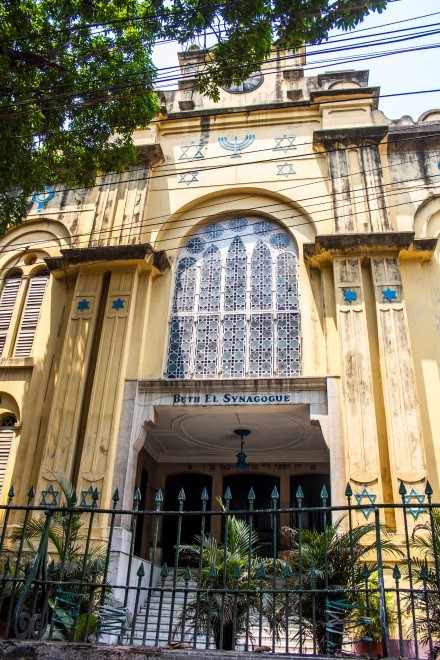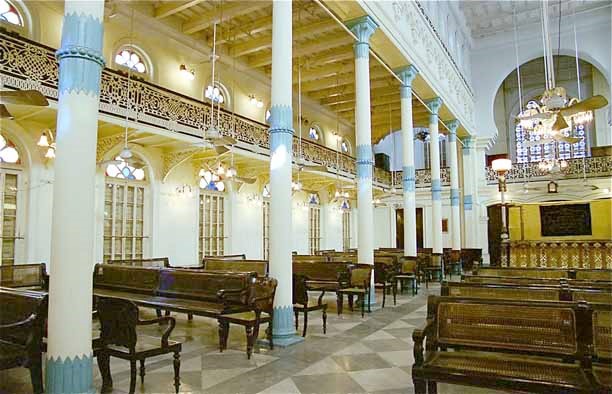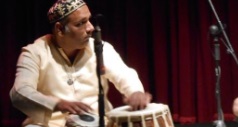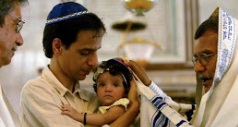BETH EL SYNAGOGUE (1856; enlarged in 1885)
26, Pollack Street
(off Brabourne Road)
Kolkata (formerly Calcutta)
West Bengal, INDIA
This sizable synagogue, albeit still fitted and maintained, is no longer a fully-functioning house of prayer due to the diminished local Jewish population. The building is now under the custodianship of the governmental Archeological Survey of India (ASI). Synagogue caretakers are regularly on duty to receive guests during the week at regular hours, so a visit should be straightforward and easy. Guests are invited to have a look at a small exhibition on the women’s gallery level on this synagogue and the Baghdadi Jewish community in Kolkata. There is no telephone number for this site, however native Jew (yet not always in Kolkata)Jael Silliman can be contacted for information at This email address is being protected from spambots. You need JavaScript enabled to view it..
Completed in 1856, this synagogue in central Kolkata at 26, Pollock Street off Brabourne Road, with shops and residences alongside, has served the city’s Beth El (Hebrew for House of God) Baghdadi congregation for more than one and one-half centuries. Its construction was made possible with funding from David Joseph Ezra and Ezekiel Judah, two local Baghdadi Jews. In 1885, to better serve the needs of a congregation that had grown in size during the 1860s and seventys, the building was enlarged and improved. These changes were paid for by another community member, Elias Shalom Gubbay.
The pale yellow synagogue, set behind a wall and gate along the busy street, is an eclectic Western-inspired composition made up of many design influences. The façade, finished in chunam (polished lime) and painted, is a classic tripartite design with recessed panels featuring rounded arched openings, pointed-arched stained glass windows, groupings of engaged pilasters, a pronounced curvilinear ceiling with a clock, and the monumental central stair leading up to a recessed porch that serves as the building’s foyer. Star of David and menorah (candelabra) appliques to the front of the synagogue, highlighted in blue, identify this civic building as a synagogue. The Beth El congregation, like the other Baghdadi communities, chose architecture devised in England and other parts of Europe, and revived in the nineteenth century, as a precedent for their houses of prayer. When seeing these synagogues for the first time, foreigners and nationals alike may be surprised by what they can regard as buildings appearing un-Indian and sometimes Christian. Yet in the colonial landscape, these imposing Baghdadi buildings were in keeping with tastes of the British and those that regarded themselves as loyal subjects of the British crown. Considering that the synagogue as an architectural genre has rarely established a specific design aesthetic anywhere in the world, the borrowing of other design inspirations at Beth El represented a common practice.
Beth El’s congregation was established in Kolkata among Baghdadi Jews who begun to immigrate to the city during the early-to-middle years of the nineteenth century. The first Baghdadi Jews to come to India did so seasonally or on a temporary basis in the late eighteenth century, arriving mostly in the western port city of Surat. In time, a permanent enclave was formed in Kolkata with others in Mumbai, Pune, and Yangon, Myanmar. Jews mostly from Iraq, but also from Iran and various Ottoman Empire lands left their homelands in search of religious tolerance, safe haven, quality of life, and opportunity. The Baghdadi Jewish came to succeed in their lines of work and daily lives, and the community as a whole became comparatively well-educated and economically comfortable in their adopted cities in India and Myanmar. Kolkata came to offer the Baghdadis affiliated with this synagogue the chance to become fully practicing Jews and productive citizens of the broader local community. It is this tradition of tolerance that Kolkata and the rest of India can be known.
The synagogue sanctuary is an impressive space able to accommodate a membership that, at its height, numbered over one hundred families. In plan, the generous triple-height nave with its centrally-positioned tebah (bimah/raised platform with a table for reading the Torah) is separated from the double-height, wide side aisles by a colonnade. The tall columns, painted white with blue capitals, mid-collars, and bases, are stylized and fabricated from iron. As a result of the Industrial Revolution, iron became a common material for structural members in buildings in England and its colonies after the 1820s, and these columns supporting the roof and screening the narrow women’s gallery (held up by decorated brackets) are indicative of this period.
While the synagogue’s white chunam walls contain some applied ornamentation, the overall space is relatively understated. Large shuttered windows with stained glass transoms, clerestories containing similar colored glass, gray and white marble floor tiles, and the tebah with its shaped brass balusters and turned wooden members set on a marble base lined with colorful tile accents are prominent design features. The ceiling of the sanctuary is flat with exposed painted steel “I” beams. Filling the sanctuary, in Baghdadi and other Indian synagogue fashion, are several freestanding wooden benches and chairs as well as various-styled hung lighting fixtures, ceiling fans, framings of Hebrew prayer verses, and wall sconces.
Beth El follows the pattern of other Baghdadi synagogues in India and Myanmar in that it contains a particularly prominent architectural feature: a sizeable heckal (ark). The heckal, positioned on the wall nearest to Jerusalem as per tradition, is set within a high half-domed niche with windows and a ceiling painted a sky blue with gold stars to resemble the heavens. The niche, because it contains the liturgically-important heckal, is raised above the main floor level, and it is framed by a pediment. From within the sanctuary, the heckal curtain (a fabric common to synagogues) and doors appear to front a conventional, cabinet-like space. Yet once they are opened, a walk-in apsidal-shaped room as deep as three meters (ten feet) and considerably wider is revealed. Here one hundred or more Torah scrolls set within decorated cases were displayed on shelves. Today, as is the case with its diminished membership, far fewer of these Torah scrolls remain in place (some relocated to synagogues around the world where Beth El’s members resettled).
For its major anniversaries over the years, gala events attended by congregants of Beth El and invited guests have been held here to celebrate this synagogue and its central place in local Jewish and broader Kolkata life. As a result of political and social changes in India that started in the 1950s, India’s Baghdadi Jewish community decreased precipitously, and with that came the decline of synagogue activity in Kolkata. Beth El, a property restored by the Architectural Survey of India (ASI) at the turn of this century and today a protected heritage building, remains open and can be visited, yet today it struggles to function as a synagogue due to the contraction of its membership. In 2015, the Baghdadi Jewish population of Kolkata was estimated to number only twenty people. Religious prayer services are no longer conducted here, although holiday ones are still led in the sanctuary and on the Sabbath, a lamp is lit in the sanctuary by a resident Jew. Beth El continues to be lovingly watched over by dedicated Muslim caretakers who, like the Baghdadi Jewish community left here, recognize the building as an important religious and civic monument that has been a part of the history and fabric of the Kolkata for many years.

Exterior

Interior








